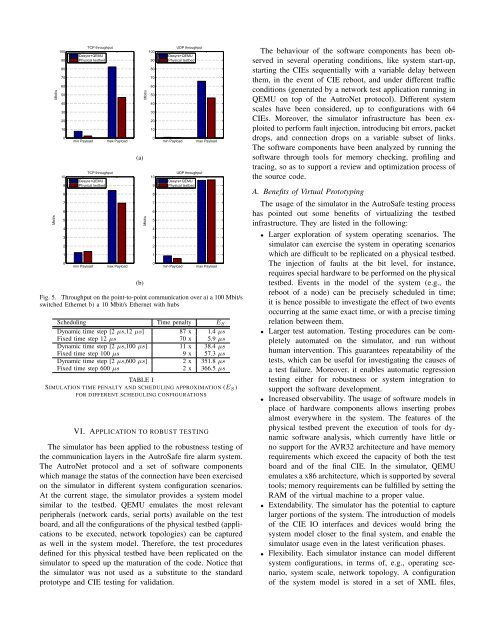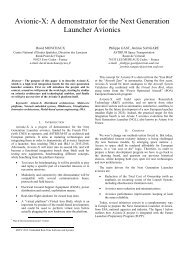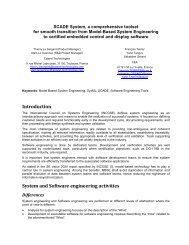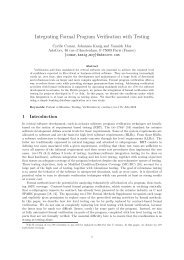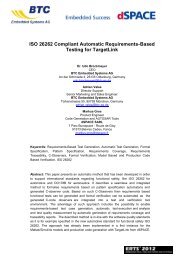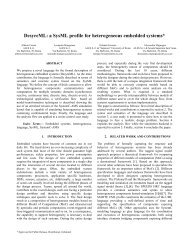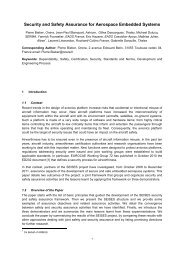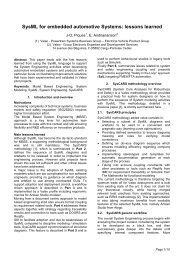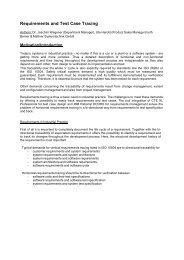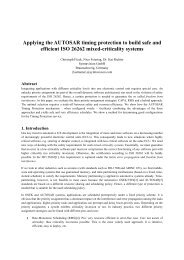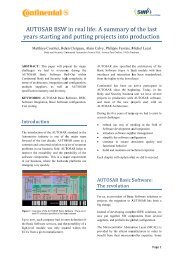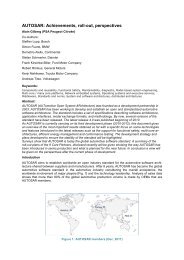A Simulator based on QEMU and SystemC for Robustness ... - SEE
A Simulator based on QEMU and SystemC for Robustness ... - SEE
A Simulator based on QEMU and SystemC for Robustness ... - SEE
Create successful ePaper yourself
Turn your PDF publications into a flip-book with our unique Google optimized e-Paper software.
Mbit/s<br />
Mbit/s<br />
100<br />
90<br />
80<br />
70<br />
60<br />
50<br />
40<br />
30<br />
20<br />
10<br />
0<br />
10<br />
9<br />
8<br />
7<br />
6<br />
5<br />
4<br />
3<br />
2<br />
1<br />
0<br />
min Payload<br />
TCP throughput<br />
Desyre+<strong>QEMU</strong><br />
Physical testbed<br />
min Payload<br />
TCP throughput<br />
Desyre+<strong>QEMU</strong><br />
Physical testbed<br />
max Payload<br />
max Payload<br />
(a)<br />
(b)<br />
Mbit/s<br />
Mbit/s<br />
100<br />
90<br />
80<br />
70<br />
60<br />
50<br />
40<br />
30<br />
20<br />
10<br />
0<br />
10<br />
9<br />
8<br />
7<br />
6<br />
5<br />
4<br />
3<br />
2<br />
1<br />
0<br />
min Payload<br />
UDP throughput<br />
Desyre+<strong>QEMU</strong><br />
Physical testbed<br />
min Payload<br />
UDP throughput<br />
Desyre+<strong>QEMU</strong><br />
Physical testbed<br />
max Payload<br />
max Payload<br />
Fig. 5. Throughput <strong>on</strong> the point-to-point communicati<strong>on</strong> over a) a 100 Mbit/s<br />
switched Ethernet b) a 10 Mbit/s Ethernet with hubs<br />
Scheduling Time penalty E S<br />
Dynamic time step [2 µs,12 µs] 87 x 1.4 µs<br />
Fixed time step 12 µs 70 x 5.9 µs<br />
Dynamic time step [2 µs,100 µs] 11 x 38.4 µs<br />
Fixed time step 100 µs 9 x 57.3 µs<br />
Dynamic time step [2 µs,600 µs] 2 x 351.8 µs<br />
Fixed time step 600 µs 2 x 366.5 µs<br />
TABLE I<br />
SIMULATION TIME PENALTY AND SCHEDULING APPROXIMATION (E S )<br />
FOR DIFFERENT SCHEDULING CONFIGURATIONS<br />
VI. APPLICATION TO ROBUST TESTING<br />
The simulator has been applied to the robustness testing of<br />
the communicati<strong>on</strong> layers in the AutroSafe fire alarm system.<br />
The AutroNet protocol <strong>and</strong> a set of software comp<strong>on</strong>ents<br />
which manage the status of the c<strong>on</strong>necti<strong>on</strong> have been exercised<br />
<strong>on</strong> the simulator in different system c<strong>on</strong>figurati<strong>on</strong> scenarios.<br />
At the current stage, the simulator provides a system model<br />
similar to the testbed. <strong>QEMU</strong> emulates the most relevant<br />
peripherals (network cards, serial ports) available <strong>on</strong> the test<br />
board, <strong>and</strong> all the c<strong>on</strong>figurati<strong>on</strong>s of the physical testbed (applicati<strong>on</strong>s<br />
to be executed, network topologies) can be captured<br />
as well in the system model. There<strong>for</strong>e, the test procedures<br />
defined <strong>for</strong> this physical testbed have been replicated <strong>on</strong> the<br />
simulator to speed up the maturati<strong>on</strong> of the code. Notice that<br />
the simulator was not used as a substitute to the st<strong>and</strong>ard<br />
prototype <strong>and</strong> CIE testing <strong>for</strong> validati<strong>on</strong>.<br />
The behaviour of the software comp<strong>on</strong>ents has been observed<br />
in several operating c<strong>on</strong>diti<strong>on</strong>s, like system start-up,<br />
starting the CIEs sequentially with a variable delay between<br />
them, in the event of CIE reboot, <strong>and</strong> under different traffic<br />
c<strong>on</strong>diti<strong>on</strong>s (generated by a network test applicati<strong>on</strong> running in<br />
<strong>QEMU</strong> <strong>on</strong> top of the AutroNet protocol). Different system<br />
scales have been c<strong>on</strong>sidered, up to c<strong>on</strong>figurati<strong>on</strong>s with 64<br />
CIEs. Moreover, the simulator infrastructure has been exploited<br />
to per<strong>for</strong>m fault injecti<strong>on</strong>, introducing bit errors, packet<br />
drops, <strong>and</strong> c<strong>on</strong>necti<strong>on</strong> drops <strong>on</strong> a variable subset of links.<br />
The software comp<strong>on</strong>ents have been analyzed by running the<br />
software through tools <strong>for</strong> memory checking, profiling <strong>and</strong><br />
tracing, so as to support a review <strong>and</strong> optimizati<strong>on</strong> process of<br />
the source code.<br />
A. Benefits of Virtual Prototyping<br />
The usage of the simulator in the AutroSafe testing process<br />
has pointed out some benefits of virtualizing the testbed<br />
infrastructure. They are listed in the following:<br />
• Larger explorati<strong>on</strong> of system operating scenarios. The<br />
simulator can exercise the system in operating scenarios<br />
which are difficult to be replicated <strong>on</strong> a physical testbed.<br />
The injecti<strong>on</strong> of faults at the bit level, <strong>for</strong> instance,<br />
requires special hardware to be per<strong>for</strong>med <strong>on</strong> the physical<br />
testbed. Events in the model of the system (e.g., the<br />
reboot of a node) can be precisely scheduled in time;<br />
it is hence possible to investigate the effect of two events<br />
occurring at the same exact time, or with a precise timing<br />
relati<strong>on</strong> between them.<br />
• Larger test automati<strong>on</strong>. Testing procedures can be completely<br />
automated <strong>on</strong> the simulator, <strong>and</strong> run without<br />
human interventi<strong>on</strong>. This guarantees repeatability of the<br />
tests, which can be useful <strong>for</strong> investigating the causes of<br />
a test failure. Moreover, it enables automatic regressi<strong>on</strong><br />
testing either <strong>for</strong> robustness or system integrati<strong>on</strong> to<br />
support the software development.<br />
• Increased observability. The usage of software models in<br />
place of hardware comp<strong>on</strong>ents allows inserting probes<br />
almost everywhere in the system. The features of the<br />
physical testbed prevent the executi<strong>on</strong> of tools <strong>for</strong> dynamic<br />
software analysis, which currently have little or<br />
no support <strong>for</strong> the AVR32 architecture <strong>and</strong> have memory<br />
requirements which exceed the capacity of both the test<br />
board <strong>and</strong> of the final CIE. In the simulator, <strong>QEMU</strong><br />
emulates a x86 architecture, which is supported by several<br />
tools; memory requirements can be fulfilled by setting the<br />
RAM of the virtual machine to a proper value.<br />
• Extendability. The simulator has the potential to capture<br />
larger porti<strong>on</strong>s of the system. The introducti<strong>on</strong> of models<br />
of the CIE IO interfaces <strong>and</strong> devices would bring the<br />
system model closer to the final system, <strong>and</strong> enable the<br />
simulator usage even in the latest verificati<strong>on</strong> phases.<br />
• Flexibility. Each simulator instance can model different<br />
system c<strong>on</strong>figurati<strong>on</strong>s, in terms of, e.g., operating scenario,<br />
system scale, network topology. A c<strong>on</strong>figurati<strong>on</strong><br />
of the system model is stored in a set of XML files,


